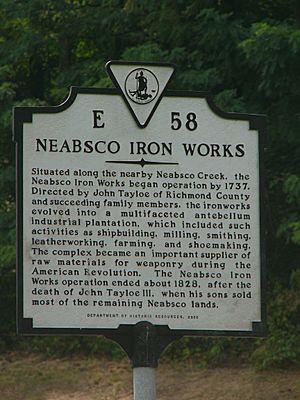Neabsco Iron Works facts for kids
The Neabsco Iron Works was a very important industrial site located in Woodbridge, Virginia, USA. It covered a huge area, about 5,000 acres, right next to the Neabsco Creek. This place was much more than just an iron factory. It was a large, busy operation that also included farming, making leather items, grinding grain, building ships, making shoes, and working with metal. It even helped supply materials for weapons during the American Revolution.
The business started by John Tayloe I grew even bigger with his son, John Tayloe II. In 1756, John Tayloe II bought another company called the Occoquan Ironworks. He then ran both the Neabsco and Occoquan ironworks together as one large business.
Contents
History of the Neabsco Iron Works
The Neabsco Iron Works was the very first iron factory in northern Virginia. It was started around 1737 by John Tayloe I. He was a very wealthy landowner in Virginia and owned several iron factories. His son, John Tayloe II, later became a partner in the nearby Occoquan Iron Works.
Even Thomas Jefferson wrote about the Neabsco Iron Works. In his book, Notes on the State of Virginia, he mentioned that iron was made at Neabsco. He noted that they used "pigs" (raw iron blocks) brought in from Maryland.
Why Neabsco was a Good Location
The Neabsco site was perfect for an iron works for several reasons:
- Trees for Fuel: It had 3,000 to 5,000 acres of trees. These trees were cut down to make charcoal, which was needed to heat the blast furnaces. Making charcoal was a very skilled and involved process.
- Iron Ore: The area also had large amounts of iron ore, which is the rock from which iron is extracted.
- Water Power: A creek with lots of flowing water provided power. This water was used to operate bellows for the furnaces and to run mills.
- Transportation: The site was located where the creek was deep enough for boats. This meant "pig iron" (raw, unworked iron) could be loaded onto boats. It was then shipped less than a mile downstream to Neabsco Harbor on the Potomac River. From there, the iron could be transferred to larger ships that could travel on the ocean. The site was also close to a major road called the Kings Highway.
Even though there was some iron ore on site, much of it was not very good quality. So, more ore had to be brought in by boat from Tayloe's mines in Maryland. Many workers, some of whom were forced to work there, provided the labor for the iron works.
Why the Iron Works Closed
The Neabsco Iron Works stopped operating around 1820. It could no longer compete with cheaper iron being made in the northern parts of the country. Also, the factory had used up most of the available trees for firewood. It's estimated that it took half an acre of trees to produce just one ton of pig iron.
Current Condition of the Site
Today, not much is left of the Neabsco Iron Works. The forest has grown back over the slopes. You can still find some pits, a few stones from the old furnaces, and parts of building foundations. There are also some old service roads and paths, along with eroded water channels. Pieces of slag (waste material from iron blasting) are scattered across the terraced work areas above where the two furnaces once stood.
The Neabsco Creek and Neabsco Harbor are now filled with silt (mud and sand). This happened because of widespread deforestation for tobacco farming and lots of building upstream. The original Neabsco industrial area was very large. It stretched from Powell's Creek in the south to the Occoquan River in the north. It went from Route One in the east to a line drawn at Bonita Fitzgerald Drive in the west. Both the Occoquan and Neabsco iron works eventually cleared most of the trees in this huge area, mainly to make charcoal.
The small part of the original industrial site that remains today is special for the Woodbridge, Virginia, area. Most large pieces of land in Woodbridge have been developed with buildings. This includes most of the Neabsco Watershed. However, the Neabsco Iron Works site is in a very steep valley along the Neabsco Creek. When Interstate 95 was built next to the site and crossed Neabsco Creek, some parts of the old works might have been destroyed forever.
The site is not a protected area right now. It's a neglected forest and creek area that is hard to reach. It is mostly used for off-roading and some hiking. However, there are some early plans in Prince William County to protect this area because of its historical importance.
Gallery
- Remnants of the Neabsco Iron Works
-
How pig iron is made, in a colonial blast furnace, from a display at Elizabeth Furnace












